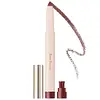Natasha Denona Mini Biba Eyeshadow Palette Versus Rare Beauty All of the Above Weightless Eyeshadow Stick
What's inside
What's inside
 Key Ingredients
Key Ingredients

 Benefits
Benefits

No benefits
 Concerns
Concerns

 Ingredients Side-by-side
Ingredients Side-by-side

Synthetic Fluorphlogopite
Zinc Stearate
Cosmetic ColorantDimethicone
EmollientTriethoxycaprylylsilane
Caprylyl Glycol
EmollientEthylhexylglycerin
Skin ConditioningHdi/Trimethylol Hexyllactone Crosspolymer
Silica
AbrasiveCI 77891
Cosmetic ColorantCI 77491
Cosmetic ColorantCI 77492
Cosmetic ColorantCI 77499
Cosmetic ColorantCI 75470
Cosmetic ColorantMica
Cosmetic ColorantCalcium Aluminum Borosilicate
Octyldodecyl Stearoyl Stearate
EmollientCaprylic/Capric Triglyceride
MaskingCetyl Dimethicone
EmollientCalcium Titanium Borosilicate
AbrasiveHydrogenated Palm Kernel Glycerides
EmollientDimethicone/Vinyl Dimethicone Crosspolymer
Skin ConditioningLauryl Dimethicone
Skin ConditioningTin Oxide
AbrasiveHydrogenated Palm Glycerides
EmollientLaureth-4
EmulsifyingCI 77000
Cosmetic ColorantCI 77163
Cosmetic ColorantCI 19140
Cosmetic ColorantSqualane
EmollientTrimethylsiloxysilicate
EmollientHydrogenated Styrene/Isoprene Copolymer
Boron Nitride
AbsorbentPentaerythrityl Tetra-Di-T-Butyl Hydroxyhydrocinnamate
AntioxidantSynthetic Fluorphlogopite, Zinc Stearate, Dimethicone, Triethoxycaprylylsilane, Caprylyl Glycol, Ethylhexylglycerin, Hdi/Trimethylol Hexyllactone Crosspolymer, Silica, CI 77891, CI 77491, CI 77492, CI 77499, CI 75470, Mica, Calcium Aluminum Borosilicate, Octyldodecyl Stearoyl Stearate, Caprylic/Capric Triglyceride, Cetyl Dimethicone, Calcium Titanium Borosilicate, Hydrogenated Palm Kernel Glycerides, Dimethicone/Vinyl Dimethicone Crosspolymer, Lauryl Dimethicone, Tin Oxide, Hydrogenated Palm Glycerides, Laureth-4, CI 77000, CI 77163, CI 19140, Squalane, Trimethylsiloxysilicate, Hydrogenated Styrene/Isoprene Copolymer, Boron Nitride, Pentaerythrityl Tetra-Di-T-Butyl Hydroxyhydrocinnamate
 Reviews
Reviews

Ingredients Explained
These ingredients are found in both products.
Ingredients higher up in an ingredient list are typically present in a larger amount.
Ci 77891 is a white pigment from Titanium dioxide. It is naturally found in minerals such as rutile and ilmenite.
It's main function is to add a white color to cosmetics. It can also be mixed with other colors to create different shades.
Ci 77891 is commonly found in sunscreens due to its ability to block UV rays.
Learn more about CI 77891Dimethicone is a type of synthetic silicone created from natural materials such as quartz.
What it does:
Dimethicone comes in different viscosities:
Depending on the viscosity, dimethicone has different properties.
Ingredients lists don't always show which type is used, so we recommend reaching out to the brand if you have questions about the viscosity.
This ingredient is unlikely to cause irritation because it does not get absorbed into skin. However, people with silicone allergies should be careful about using this ingredient.
Note: Dimethicone may contribute to pilling. This is because it is not oil or water soluble, so pilling may occur when layered with products. When mixed with heavy oils in a formula, the outcome is also quite greasy.
Learn more about DimethiconeSilica, also known as silicon dioxide, is a naturally occurring mineral. It is used as a fine, spherical, and porous powder in cosmetics.
Though it has exfoliant properties, the function of silica varies depending on the product.
The unique structure of silica enhances the spreadability and adds smoothness, making it a great texture enhancer.
It is also used as an active carrier, emulsifier, and mattifier due to its ability to absorb excess oil.
In some products, tiny microneedles called spicules are made from silica or hydrolyzed sponge. When you rub them in, they lightly polish away dead skin layers and enhance the penetration of active ingredients.
Learn more about SilicaSynthetic Fluorphlogopite is the synthethic version of mica. It consists of fluorine, aluminum and silicate.
Synthetic Fluorphlogopite is used to add volume to products.
It is considered non-irritating on the skin.
Learn more about Synthetic Fluorphlogopite